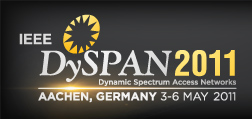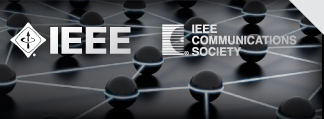| |
|
|
|
Tutorials
(Tutorial registration includes 1 morning and 1 afternoon tutorial)
Tuesday, 3 May 2011
8:30 – 17:00
Location: Institute for Networked Systems, RWTH Aachen University (transportation by shuttle bus will be provided for the participants from the conference hotel, departing 8:30 on Tuesday morning)
T1: Cognitive Wireless Networking with WARP
Presenters: Petri Mahonen (RWTH Aachen, Germany)
Ashutosh Sabharwal (Rice University, USA)
This hands-on tutorial will introduce the participants to developing cognitive radio prototypes, especially for higher layer concepts.
The first part of the tutorial will explain the WARP platform basics, including introduction to the hardware and design flows. This will include the current Rice MIMO-OFDM reference design implementation on WARP. Building on the WARP PHY, we will introduce RWTH flexible cognitive radio MAC layer design. We will discuss also the key lessons learnt from clean-slate implementations on the WARP hardware, and methods to leverage existing open-source code base.
In the second part of the tutorial, participants will have a full access to dozen WARP boards and necessary infrastructure. We would use the rest of the day for hands-on tutorial, where the participants will engage to interactive tutorial to learn in intensive course manner the basic parts of the platform and tool-chain. Furthermore, they will be able to work with several research demonstrations built by Rice and RWTH researchers. This part will also serve to encourage collaborative discussions between the workshop participants.
NOTE: Due to the finite amount of hardware resources available for this tutorial, registration will be limited.
Materials
Tutorial attendees can click the following links to download the materials for the tutorial:
http://www.inets.rwth-aachen.de/DySPAN2011/tutorial1/warplab.pdf
http://www.inets.rwth-aachen.de/DySPAN2011/tutorial1/DySPAN WARP Tutorial handout_RWTH.pdf
http://www.inets.rwth-aachen.de/DySPAN2011/tutorial1/WARPWorkshop_Lab2_noMAC.pdf
http://www.inets.rwth-aachen.de/DySPAN2011/tutorial1/cogmac.pdf
http://www.inets.rwth-aachen.de/DySPAN2011/tutorial1/halfmac_sw.pdf
http://www.inets.rwth-aachen.de/DySPAN2011/tutorial1/WARP_Tutorial_DySPAN_2011_RWTH.pdf
Username and password needed to access the materials will be given by the instructor in the beginning of the tutorial.
Further information and resources are available at the homepage of the tutorial:
http://warp.rice.edu/trac/wiki/Workshops/Aachen_2011May
Tuesday, 3 May 2011
9:00 – 12:30
Location: Berlin 1
T2: Non-Contiguous Multicarrier Transmission for Spectrally Opportunistic Wireless Access:
Design Decisions and Trade-Offs
Presenters: Alexander M. Wyglinski (Worcester Polytechnic Institute, USA)
Hanna Bogucka and Adrian Kliks (University of Technology, Poland)
Srikanth Pagadarai (Worcester Polytechnic Institute, USA)
Multicarrier modulation has been employed in numerous modern wireless communications standards due to its ability in providing high data rates while simultaneously counteracting the effects of intersymbol interference due to multipath fading channels. In the recent years, multicarrier modulation is being investigated as a possible candidate data transmission scheme for achieving spectrally agile wireless access in scenarios where unlicensed users temporarily “borrow” unoccupied licensed frequency bands while minimizing interference with spectrally adjacent signals, i.e., opportunistic wireless access. Specifically, the divide-and-conquer data transmission approach employed by multicarrier modulation makes it an attractive option for realizing wireless communication systems that do not require a single continuous transmission frequency band.
In this tutorial, we present several multicarrier transmission solutions designed for efficiently achieving opportunistic wireless access. In particular, we shall investigate two types of spectrally-agile multicarrier modulation schemes, namely, non-contiguous orthogonal frequency division multiplexing (NC-OFDM) and non-contiguous non-orthogonal frequency division multiplexing (NC-NOFDM). The viability of these two techniques employed within an opportunistic wireless access scenario is assessed using actual spectrum measurement data, and a comparative study in terms of out-of-band (OOB) interference mitigation as well as implementation complexity is provided.
Materials
Tutorial attendees can click the following link to download the materials for the tutorial:
http://www.inets.rwth-aachen.de/DySPAN2011/tutorial2/dyspan2011_tutorial_amw_hb_sp_ak.pdf
Username and password needed to access the materials will be given by the instructor in the beginning of the tutorial.
Tuesday, 3 May 2011
9:00 – 12:30
Location: Berlin 2
T3: Advanced Antennas for Cognitive Radio:
New Foundations for Transformational System Design
Presenter: Jennifer T. Bernhard (University of Illinois, Urbana-Champaign, USA)
Emerging models for cognitive radio often rely solely on abilities to sense and/or adjust operating frequencies. These approaches envision antennas in a very traditional way, assuming either broadband or, perhaps, tunable frequency operation, but nothing more. However, if included early in the system concept and design cycle, new kinds of advanced antennas, including reconfigurable antennas and novel antenna arrays, promise to deliver a much deeper knowledge of the electromagnetic environment than traditional antenna solutions, as well as a much broader range of capabilities with which to use and leverage this environment to greater effect.
This tutorial will first provide a foundational overview of antenna behavior and parameters, with an emphasis on the relationships between antenna parameters and system performance as well as the differences between theoretical and realistic antenna characteristics. Second, the tutorial will help the audience carefully consider the assumptions made about antennas for cognitive radio and the inherent limitations these assumptions impose on the final system configuration. Participants will then discuss what antenna functionality would ultimately be desired to fully sense and leverage the existing electromagnetic environment. Next, the tutorial will highlight some ongoing work in the area of innovative antennas for cognitive radio, including electrically small direction-finding arrays and reconfigurable adaptive arrays for small platforms. System-level implications of inclusion of antenna control and feedback will be addressed.
Finally, promising areas for future research and development will be presented, with emphasis placed on illumination of areas for collaboration between researchers and developers in antennas, radios, communications, signal processing, and protocols. As part of this presentation, the results of the recent NSF Enhancing Access to the Radio Spectrum Workshop will also be summarized.
Materials
Tutorial attendees can click the following link to download the materials for the tutorial:
http://www.inets.rwth-aachen.de/DySPAN2011/tutorial3/Bernhard-DySPAN_Tutoral_Slides_2011.pdf
Username and password needed to access the materials will be given by the instructor in the beginning of the tutorial.
Tuesday, 3 May 2011
9:00 – 12:30
Location: Berlin 3
T4: Dynamic Spectrum Access Related Standards
Presenters: Markus Mueck (Intel Mobile Communications, Germany)
Oliver Holland (Kings College London, UK)
Mahesh Sooriyabandara (Toshiba Research Europe Limited, UK)
Przemysław Pawełczak (University of California, Los Angeles, USA)
Significant progress is being made on the technical capabilities of mobile and wireless devices and systems in terms of, e.g., spectrum usage flexibility and radio access adaptability. Furthermore, regulations in various countries are opening up to the idea of cognitive radio and other dynamic spectrum access related paradigms. In tandem with such developments, various standards are being developed by the IEEE, ETSI and others, with a view to taking advantage of the opportunities in cognitive radio and dynamic spectrum access that are being created. This is important, because although regulations may allow such technologies to exist while ensuring that no negative impacts result, standards are necessary to ensure that the dynamic spectrum access related products developed by a range of manufacturers are compatible, will coexist efficiently, or indeed will be able to communicate and form dynamic spectrum access links and networks.
This tutorial provides a general overview of the objectives and purposes of standardization, particularly discussing the importance of standards to the viability and performance of various facets of dynamic spectrum access. It then focuses on some specific dynamic spectrum access related standards, starting with the IEEE 802.22 wireless regional area networks standard--the first standard being worked on to utilize TV Whitespace. Next it discusses the IEEE DySPAN Standards Committee (1900 series) standards as well as ongoing efforts within ETSI's Reconfigurable Radio Systems work area on standardizing a range of technologies which facilitate dynamic spectrum access concepts. Finally, the tutorial briefly touches on some lesser-known, newer, or related standards work of interest, including the relatively recent drive to extend Wi-Fi for operation in TV Whitespace (the IEEE 802.11af standards task group), the IEEE 802.19 "Wireless Coexistence" standards working group, the ECMA-392 standard, and the IEEE 802.11y and 802.16h standards.
Materials
Tutorial attendees can click the following link to download the materials for the tutorial:
http://www.inets.rwth-aachen.de/DySPAN2011/tutorial4/2011_05_DySPAN_Tutorial_v1.5.pdf
Username and password needed to access the materials will be given by the instructor in the beginning of the tutorial.
Tuesday, 3 May 2011
13:30 – 17:00
Location: Berlin 1
T5: Dynamic Spectrum Market
Presenters: Randall Berry and Michael Honig (Northwestern University, USA)
Dynamic spectrum markets are emerging as a key paradigm for rethinking current spectrum allocations. Such markets could improve the efficiency of radio spectrum allocations by allowing under-utilized spectrum to be re-allocated (traded) over short time-scales in response to changing demand. While technical advances, such as frequency-agile and cognitive radios, are needed to facilitate flexible spectrum use and distributed interference management, introducing markets raises additional issues that intersect technology, micro-economics, and policy.
This tutorial will first motivate dynamic spectrum markets and relate these to current and proposed spectrum sharing mechanisms. We will then discuss how the choice of spectrum assets to be traded may influence the technology and the resulting market mechanism. Potential market structures that could emerge will be discussed along with associated interference management issues. We will conclude with a comparison of markets with other mechanisms for spectrum sharing (in particular, cognitive radio) and discuss some possible implications for wireless system design.
Materials
Tutorial attendees can click the following link to download the materials for the tutorial:
http://www.inets.rwth-aachen.de/DySPAN2011/tutorial5/spec_markets_v3.pdf
Username and password needed to access the materials will be given by the instructor in the beginning of the tutorial.
Tuesday, 3 May 2011
13:30 – 17:00
Location: Berlin 3
T6: Policy Questions Relevant to Dynamic Spectrum and Cognitive Radios:
An Introduction from a Technologist’s Point of View
Presenter: Anant Sahai (University of California, Berkeley, USA)
Although dynamic spectrum access is inherently an interdisciplinary area, many have difficulty interacting across the technology/policy divide. Policy folks tend to have simplified models for what the technological constraints and possibilities are. One role of technology/policy interaction is to help them upgrade their outdated technical models, while still keeping things simple and understandable.
In an ideal world, the technology folks would also have simplified models for what the policy concerns and constraints are. These too can become outdated and require upgrades. Successful interaction requires both sides to not only have simplified models of each other's concerns and constraints, but also to know what the other's simplified models are for their own concerns and constraints. Being able to arbitrage across this interface is a powerful way to gain new insights.
This tutorial is designed to quickly introduce the key policy concerns to a technical audience and will do so with reference to a selection of seminal papers. This will be done in a beginner-friendly way. I will try to make explicit the simplified technology models that policy folks rely upon as well as to help synthesize simplified models for the policy concerns that technology folks can use to guide their own work. This tutorial should attract a mixed audience so that productive interaction can start happening during the event itself.
One desired side-effect is for this tutorial to better prepare people to appreciate the sessions in the conference. And so, as a special treat, this tutorial will have a bonus recap session that will meet at the end of the conference to further discuss the new policy ideas and papers that emerge at this conference, as well as to put the exciting new emerging technology ideas within a policy context.
NOTE: An additional follow-up 90-minute session to this tutorial will be conducted during the afternoon of Friday 6 May 2011 in the room Berlin 2.
|
|
| |
|
|
|

|







